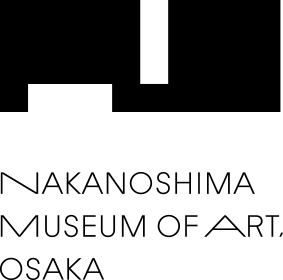
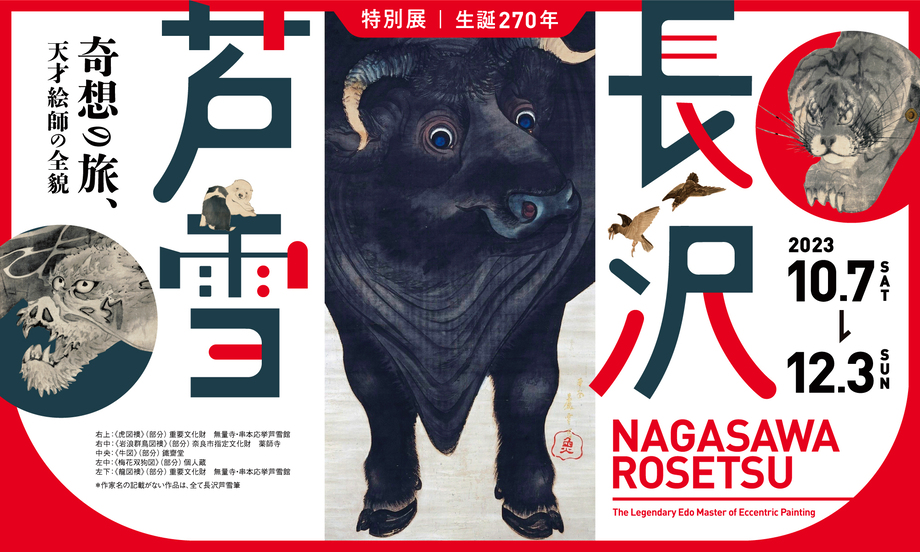
This event has ended.
NAGASAWA ROSETSU: The Legendary Edo Master of Eccentric Painting
2023-10-07 – 2023-12-03
Summary
Rosetsu was active in Kyoto in the mid-Edo period, and he was a senior disciple of Maruyama Okyo, who brought sketching directly from nature into the world of Japanese painting. Rosetsu’s outstanding descriptive abilities, eccentric ideas and bold compositions complemented his willingness to please and entertain his audience through a unique world view with a spirit of fun and surprise, which contributed to his popularity.
Rosetsu loved to paint and energetically pursued new forms of expression and techniques. Even now, more than 200 years later, his masterpieces continue to fascinate viewers. This exhibition covers his early years through his final years, bringing together a body of work that includes such representative works as Dragon and Tiger on fusuma door panels (an Important Cultural Property) along with works exhibited for the first time as we explore the eccentric genius of Nagasawa Rosetsu.
Information about the Exhibition
| Dates | October 7 – December 3, 2023 Closed on Mondays (except October 9). Closed on October 10. |
|---|---|
| Opening hours | 10:00 – 17:00 (last entry 16:30) |
| Venue | Nakanoshima Museum of Art, Osaka 4F Galleries |
| Sponsorship | DNP (Dai Nippon Printing) |
| Cooperation | Yamato Transport |
| Admission fee | Adults 1800 yen (advance sales/groups 1600 yen) University / High school students 1100 yen (advance sales/groups, 900 yen) Junior high school / Elementary students: 500 yen (advance sales/groups 300 yen) Member privileges (free admission, discounts) are available for this exhibition Wakuwaku Discount Ticket (a set of two adult tickets) 2800 yen (Only available during advance ticket sales.) * Family Days (October 28 and 29): Elementary and junior high school students are admitted free of charge (when accompanied by a parent or guardian). * Advance ticket sales: July 7 (10:00)–October 6 (23:59) * The museum may close without notice in the event of disasters or other circumstances beyond our control. * Prices include tax. Group prices are for groups of at least 20 visitors. * Persons holding an official Disability Certificate are admitted for half the price of a same-day ticket (including one attendant). Apply at the ticket counter (2F) on the day. (No advance reservation required.) * Certification of eligibility for special rates must be presented before admission for all except regular adult rates. * For this exhibition, regular adult rates apply to Osaka residents aged 65 or older. Main ticket sales locations Osaka Nakanoshima Museum Ticket Site, Asoview!, Online Ticket (etix), Lawson Ticket (L Code : 53115) Seven Eleven (Seven Code: 101-533), E-plus, Rakuten Ticket |
Highlights
1. Nagasawa Rosetsu’s first retrospective exhibition in Osaka
About a hundred of Rosetsu’s representative works in Japan, including newly discovered works and four important cultural properties, are brought together in a single exhibition.
* A substantial proportion of the artworks will be rotated during the exhibition period.
2. Eight room partition paintings (fusuma sliding door panels) will be exhibited. For the first time in twenty-three years, fusuma sliding door paintings from Saikoji Temple (Shimane), Muryoji Temple (Wakayama), Kozanji Temple (Wakayama), Yakushiji Temple (Nara), and Daijoji Temple (Hyogo) will be exhibited together!
3. Lots of adorable animals Adults and children will both be excited and thrilled. These unique depictions of animals by Rosetsu are a must-see. So lively in their movement, we feel we can hear their conversations.
4. Introducing Rosetsu’s world on large display panels Attention is focused on his superb technique and delicate brushwork. (Production Cooperation: DNP Art Communications)
Nagasawa Rosetsu Biography
| Year (AD) | Age (calendar years) | Event |
|---|---|---|
| 1754 | 1 | Born in the Tanba Sasayama Domain (present-day Hyogo Prefecture) to a samurai family, he was raised in Yodo, south of Kyoto. His personal names were Masakatsu and Gyo (fish), and the characters/seals he used were Hyokei and Inkyo. |
| His teens | At first, he painted under the name Ushu. After that, he became a disciple of Murayama Okyo (1773–95) who was popular for paintings based on realistic sketching from nature. | |
| His mid-twenties | Began to use the name “Rosetsu” for painting. While on the one hand he created works faithfully following Okyo’s techniques, from early on he sought his own style. He stood out among his fellow disciples. | |
| 1782 | 29 | He is listed, along with Okyo and others, in the section on painters in The Heian Jinbutsushi a directory of prominent cultural figures of the time. |
| His early thirties | He continued to improve his skills through painting such works as hanging scrolls and small screens. He began to use his “fish” seal from around this time. | |
| 1786 | 33 | Representing Okyo, he went to zen temples in the southern part of present-day Wakayama Prefecture, where he painted fusuma sliding door paintings. Taking on the challenge of large-scale paintings which he had not attempted before, he completed works of unrestrained brushwork and bold composition such as Muryoji Temple’s Dragon and Tiger on fusuma panels. Arriving in about October, he stayed in Nanki for about six months. * Employing eccentric concepts such as dynamic composition and audacious closeups, he entertained people with works full of humor and charm. |
| 1789 | 36 | Around this time he goes to Nara. |
| 1790 | 37 | He creates partition paintings for the Imperial Palace. |
| 1793 | 40 | The upper right corner of his “fish” seal is partially missing. |
| 1794 | 41 | Around this time he lives in Hiroshima. |
| 1795 | 42 | He writes calligraphy (practices kigo) at Daijoji Temple in Hyogo.“Kigo” means to write characters or paint with a brush. * He produced many original works such as Five Hundred Arhats. |
| 1799 | 46 | On June 8, 1799, he passes away in Osaka. |
Composition
Chapter One: Learning from Maruyama Okyo
Nagasawa Rosetsu was born in Tanba province, the son of a samurai who served the Sasayama clan and later the Yodo clan. He changed his name to “Nagasawa” to become a painter, and became a disciple of Maruyama Okyo (1733-95), who was leading the art world at that time. From his late twenties more and more of his works were signed “Rosetsu” and gradually he began to receive requests for large works such as folding screens. The works exhibited in this chapter are from his early period, when, in his midteens and under the name “Ushu,” he was following Okyo’s style in depicting figures of women and in animal paintings, while searching for his own style.
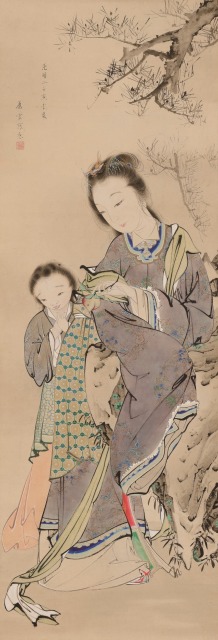
NAGASAWA Rosetsu
Chinese Goddess, Xiwangmu1782
Private collection
* Exhibited in Part 1 (until November 5)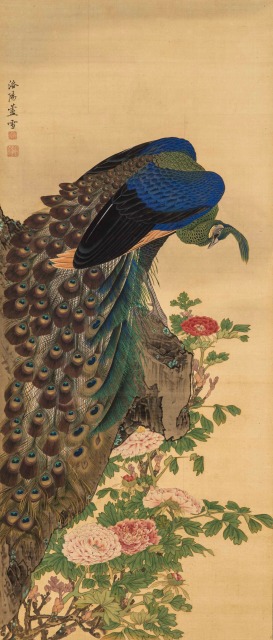
NAGASAWA Rosetsu
Peonies and PeacockEarly Tenmei era (1781-89)
Shimogoryo Shrine
* Exhibited in Part 2 (from November 7)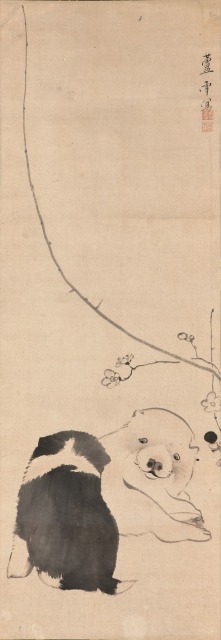
NAGASAWA Rosetsu
A Pair of Puppies in Plum BlossomsEdo Period, 18th Century
Private collection
* Exhibited in Part 2 (from November 7)
Chapter Two: Painting (Kigo) in Nanki
From around October 1786 to February of the following year, Rosetsu went to the Nanki region (present-day southern Wakayama Prefecture, also known as Kinan) on behalf of his teacher, and visited temples, including Muryoji in Kushimoto-cho, the southernmost town on Honshu, to paint fusuma sliding door panels. Perhaps thanks to the warm climate, he painted many works with much bolder brush strokes than his previous works. In this chapter, you will see many large-scale paintings, including Dragon Sliding Doors (Saikoji, Shimane), which he painted just before he left for Nanki, and Dragon and Tiger fusuma panels (Muryoji, Wakayama), which he produced during his stay there.
-

NAGASAWA Rosetsu
Tiger(Important Cultural Property)
before 1786
Kushimoto Okyo Rosetsu Art Museum at Muryoji Temple, Wakayama
* Exhibited in Part 1 (until November 5) 
NAGASAWA Rosetsu
Dragon(Important Cultural Property)
1786
Kushimoto Okyo Rosetsu Art Museum at Muryoji Temple, Wakayama
* Exhibited in Part 1 (until November 5)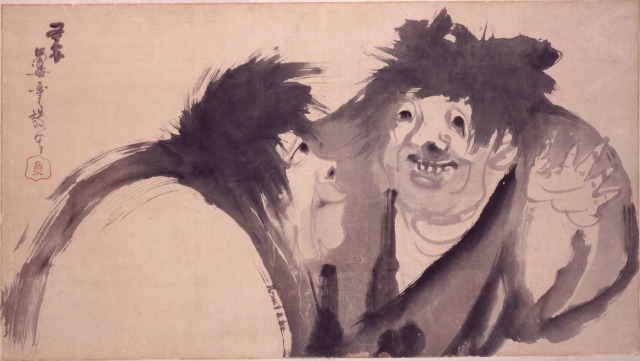
NAGASAWA Rosetsu
Hanshan and shide (Wakayama Prefecture designated Cultural Properrty)
1787
Kozanji Temple, Wakayama
* Exhibited in Part 1 (until November 5)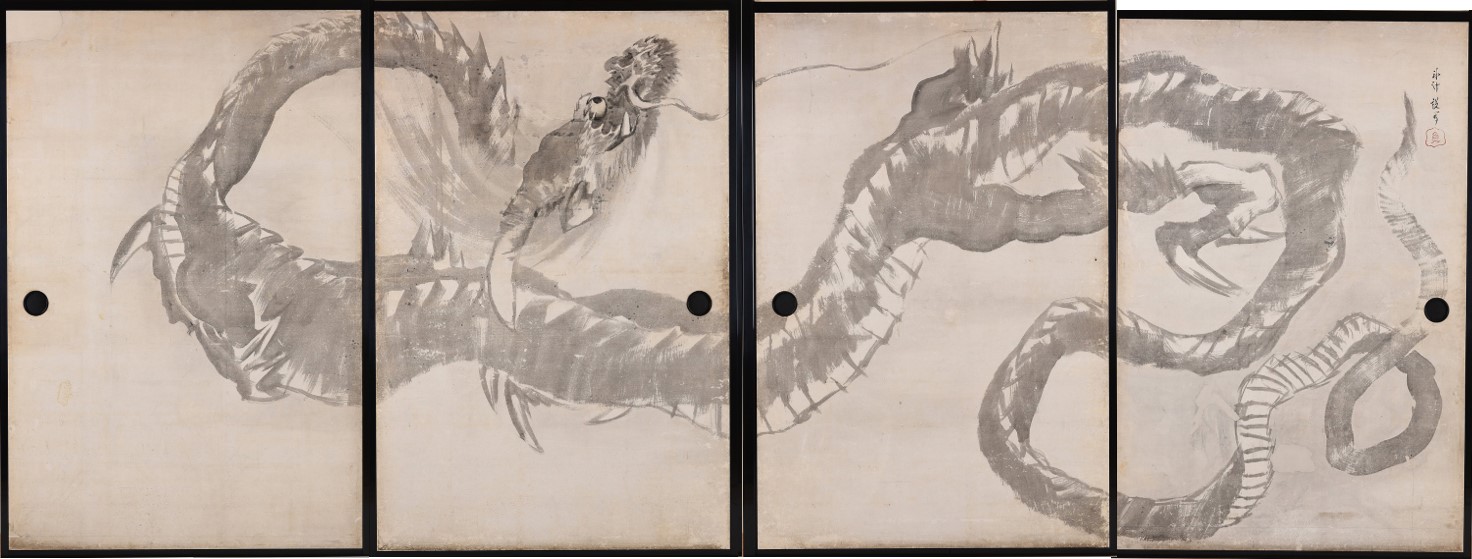
NAGASAWA Rosetsu
Dragons(Matsue City designated Cultural Property)
before 1786
Saikoji Temple, Shimane
* Exhibited in Part 2 (from November 7)
Chapter Three: Newer and freer
After his stay in Nanki, in addition to participating in the production of fusuma paintings for the Imperial Palace to replace those destroyed in the great fire of Kyoto, Rosetsu also went to Nara and Hiroshima to create works there. Of the disciples who tried to succeed to Okyo’s style, only Rosetsu spared no effort in reinterpreting and transforming his master’s style in order to establish a style of his own. In this chapter, we hope you will enjoy unique works of Rosetsu in his 40s, which have captivated and entertained people with their bold composition, audacious closeups, and somehow humorous and charming depictions of animals and people.
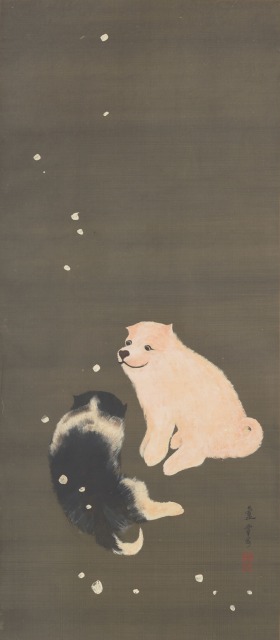
NAGASAWA Rosetsu
Puppies in the SnowEarly Tenmei (1781–89)
Hankyu Cultural Foundation, Itsuo Art Museum
* Exhibited in Part 2 (from November 7)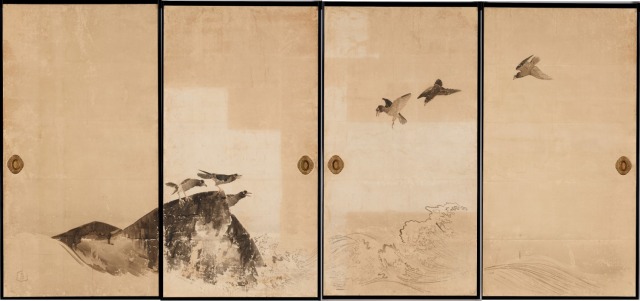
NAGASAWA Rosetsu
Crows on a Wave-swept Rock(Nara City designated Cultural Property)
Early Kansei (1789–1799)
Yakushiji Temple, Nara
* Exhibited in Part 1 (until November 5)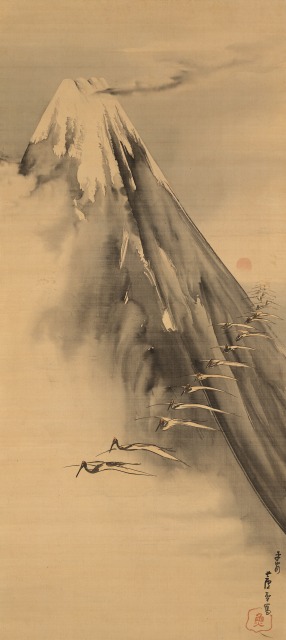
NAGASAWA Rosetsu
Cranes Flying over Mt. FujiKansei 6 (1794)
Private collection
* Exhibited in Part 2 (from November 7)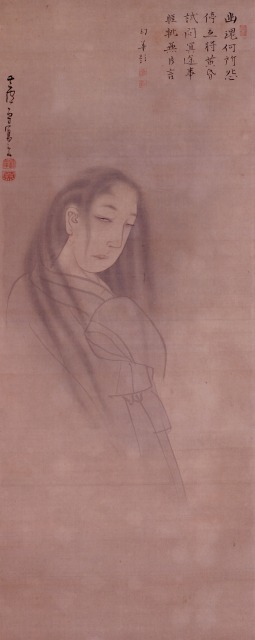
NAGASAWA Rosetsu
GhostLate Kansei (1789–1799)
Nara Prefectural Museum of Art
* Exhibited in Part 1 (until November 5)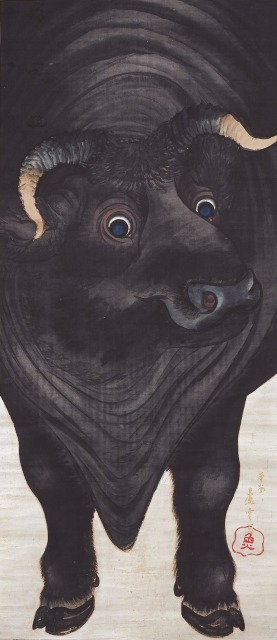
NAGASAWA Rosetsu
CowKansei, early period (1789–1799)
Tessaido
* Exhibited in Part 2 (from November 7)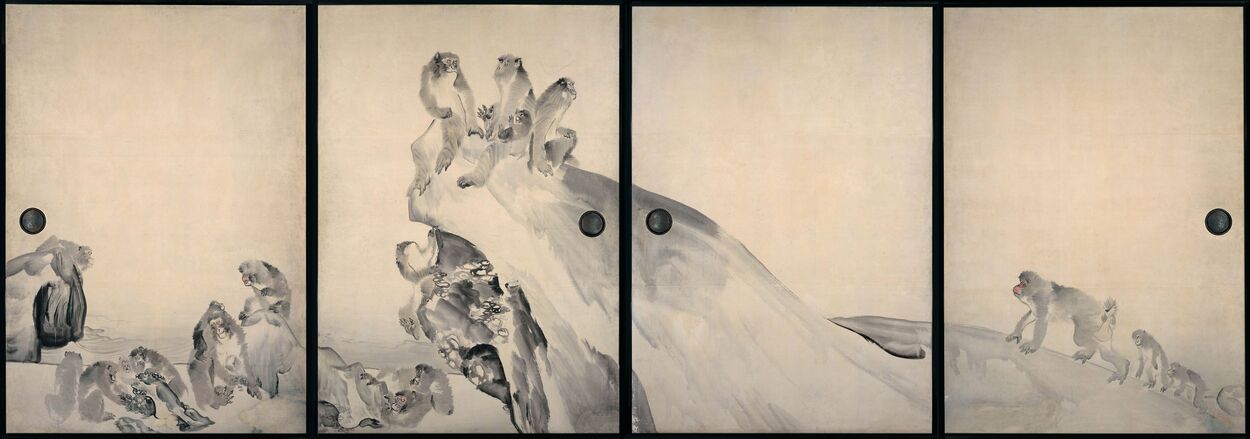
NAGASAWA Rosetsu
Monkeys on the Seashore(Important Cultural Property)1795
Daijoji, Hyogo
* Exhibited in Part 2 (from November 7)
Chapter Four: Genius painters of the same era
The eighteenth century Kyoto, where Rosetsu lived, produced many unique painters in addition to his teacher Maruyama Okyo. Ito Jakuchu (1716–1800) and Soga Shohaku (1730–81), who later came into the limelight as “eccentric painters,” were born a generation before him. Rosetsu painted many works that were in sync with their works or with themes favored by Zen Buddhism. In this chapter/section, works by Jakuchu and Shohaku are also on view, introducing the charm of the artists of the eighteenth century Kyoto art world.

ITO Jakucho
Elephant and Whale
1797
MIHO MUSEUM
* Exhibited in Part 2 (from November 7)
DIscount plan tickets
■ Wakuwaku Discount Ticket
A substantial proportion of the artworks will be rotated during the exhibition period. This set of tickets allows you to see both Part 1 and Part 2 at a discount. (Alternatively, two people can use the tickets together for one visit.)
Wakuwaku Discount Ticket (a set of two adult tickets): 2800 yen
■ Advance sale tickets
Adults: 1600 yen
University / High school students: 900 yen
Junior high school / Elementary students: 300 yen
Ticket sales locations
Ticket Site、Asoview!、Online Ticket (etix)、Lawson Ticket (L Code : 53115) 、Seven Eleven (Seven Code: 101-533)、e+、Rakuten Ticket
Ticket sales period
July 7 (10:00)–October 6 (23:59)
■ Family Days (October 28 and 29)br>
On Family Days, we welcome elementary and junior high school students free of charge (when accompanied by a parent or guardian).
Audio Guide (Japanese only)
Actor Keita Machida, who has a strong interest in history and culture, introduces the life of Nagasawa Rosetsu and the background to the creation of his many masterpieces.
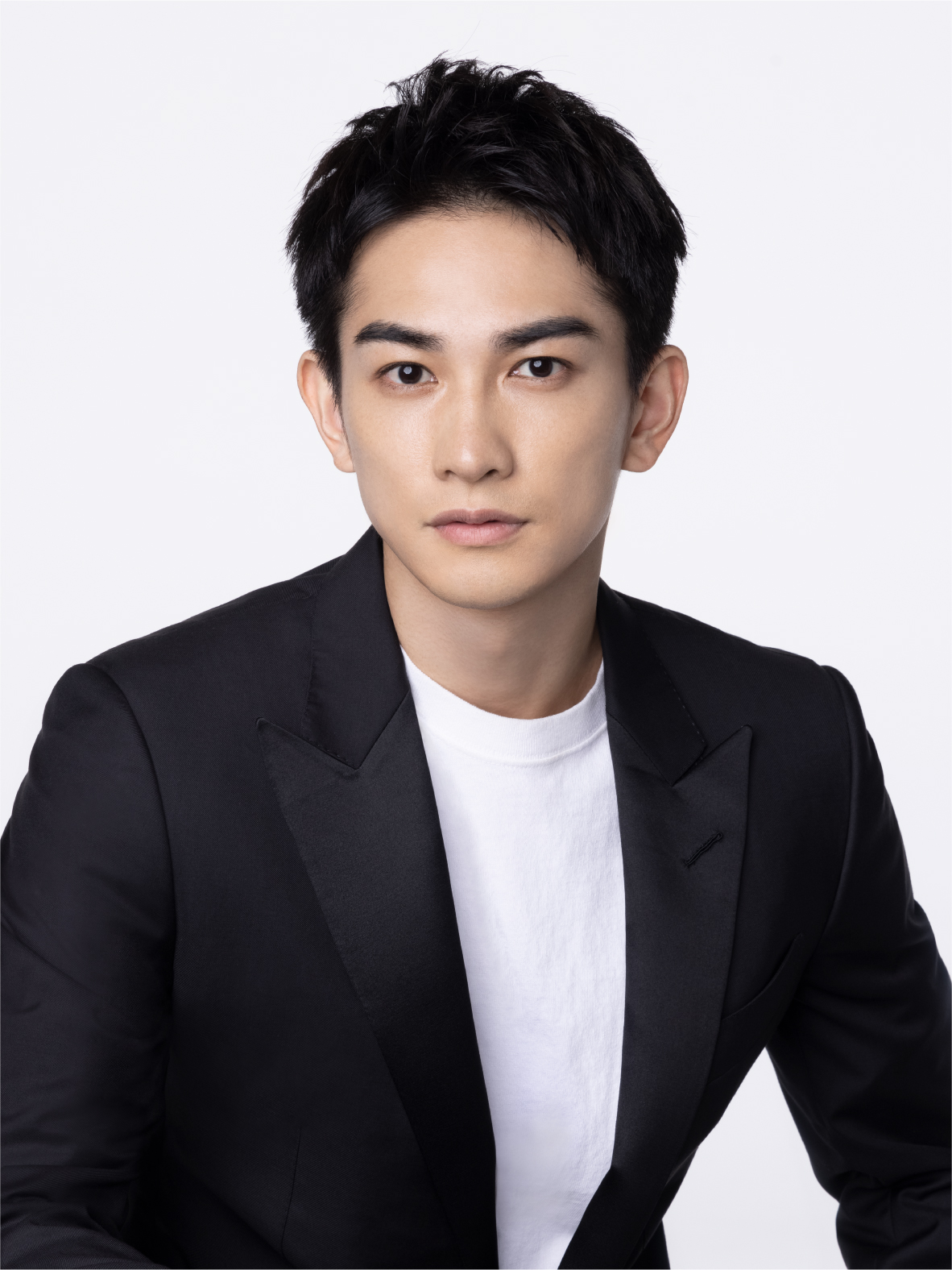
Audio guide presenter
Keita Machida
Actor Keita Machida was born on July 4, 1990, in Gunma prefecture. He is a member of the theater troupe Gekidan EXILE. Recent major appearances include the NHK Period Drama Reach Beyond the Blue Sky, the streaming drama Alice in Borderland, the dramas SUPER RICH, Teppachi! and unknown, and the movie Cherry Magic THE MOVIE. On the air now in NHK’s Mangaka Ienaga no Fukuzatsu Shakai wo Chouteigi and the WOWOW serial drama Fixer Season 2. In the fall he will appear in the movie Don’t Call it Mystery. He will also appear in the 2024 NHK Period Drama Hikaru Kimi e.
Audio guide information
▼Venue rental version
650 yen per person (tax included)
Tour time: about 35 minutes
▼App version (iOS/Android) Kiku bijutsu [listen to art]
Audio guide price: 800 yen (tax included) *limited-time use
Download the Kiku bijutsu app (free) from the link below to access the audio guide.
![]()

Contact for questions about the audio guide service
Acoustiguide Japan Ltd.
support@acoustiguide.co.jp
